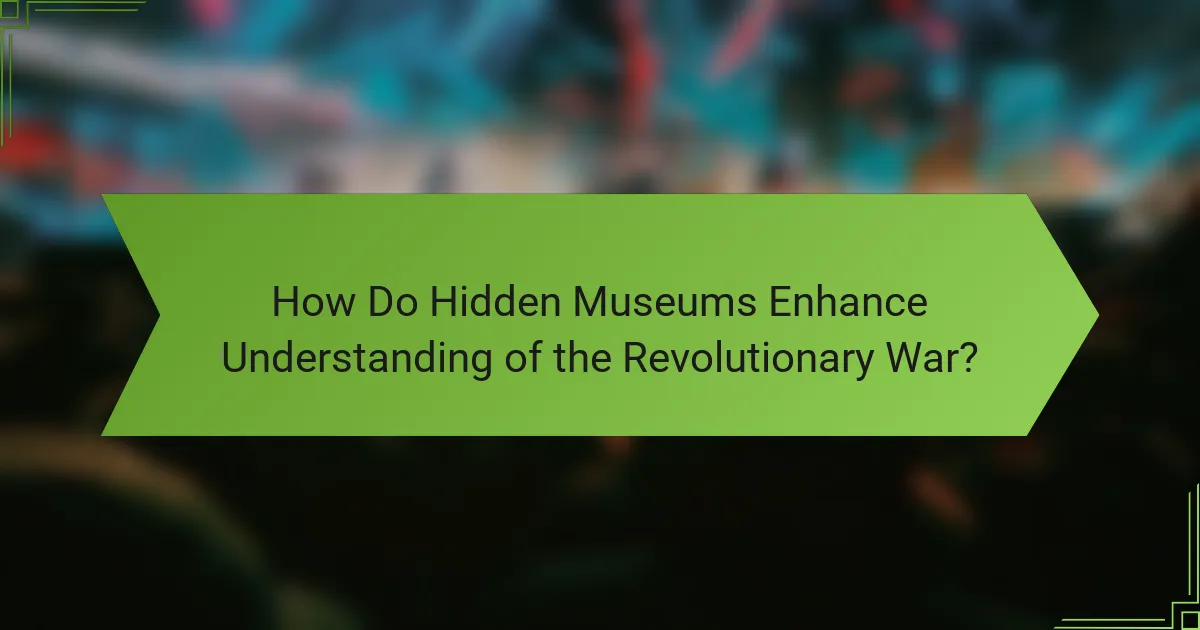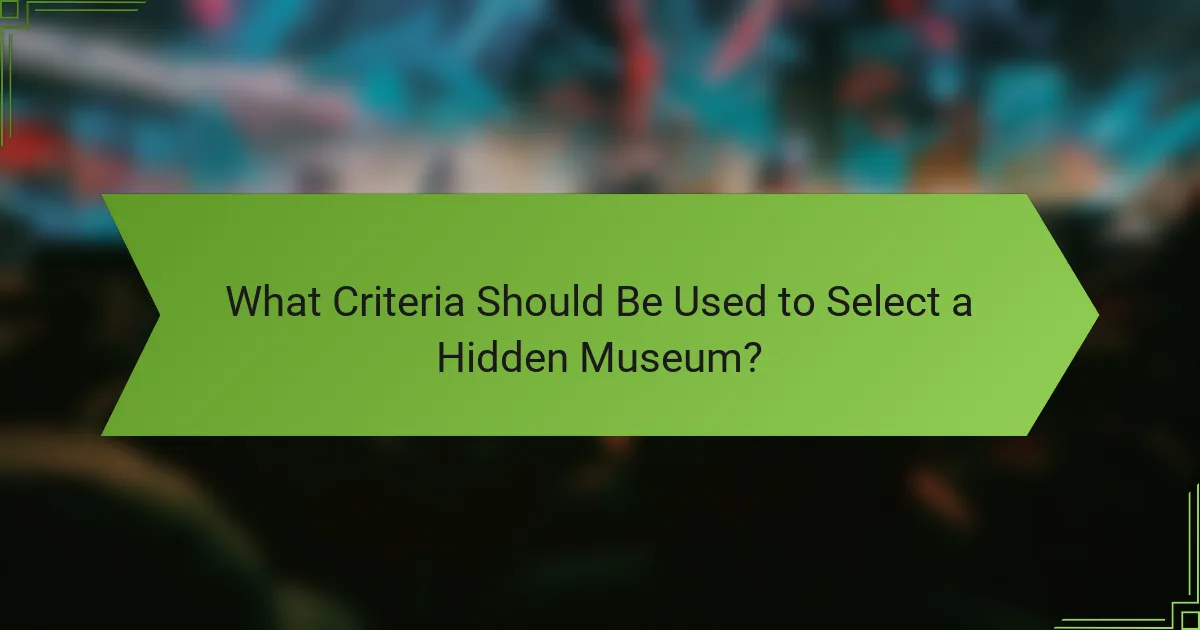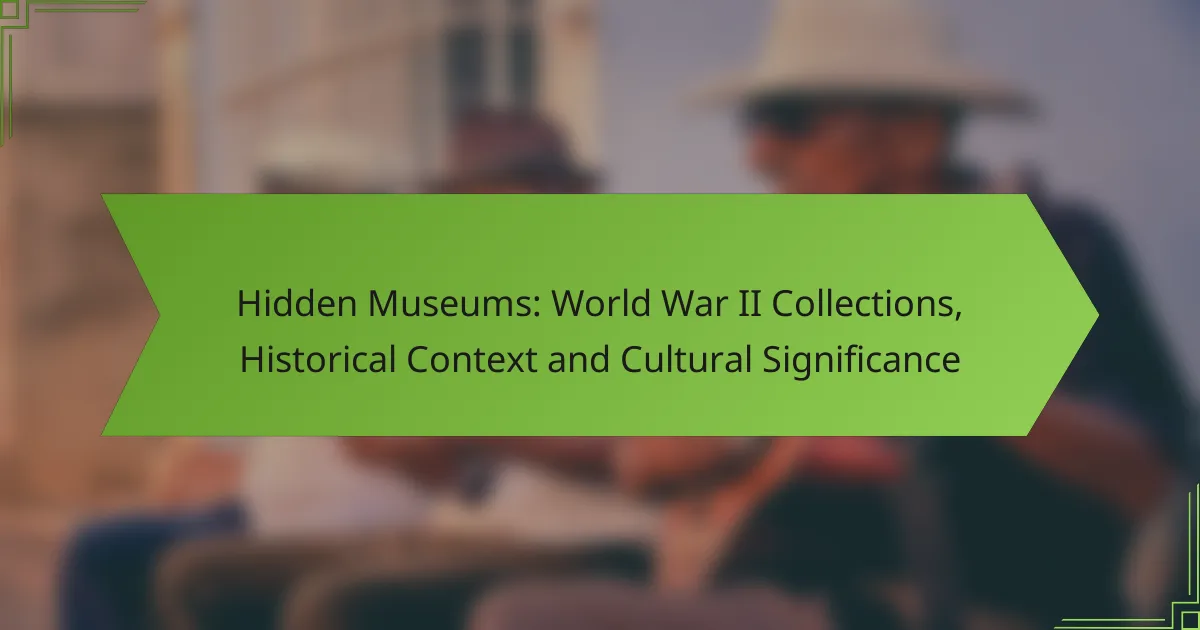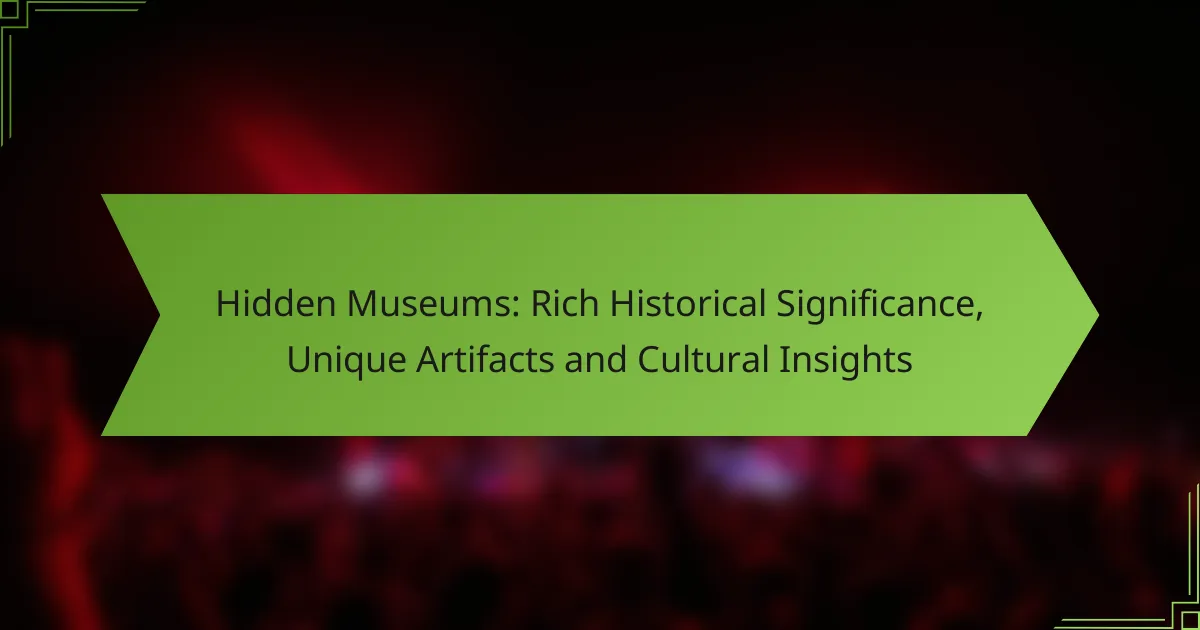Hidden museums dedicated to Revolutionary War artifacts offer a unique opportunity to explore the rich history of this transformative period in American history. By showcasing rare items and engaging exhibits, these institutions provide immersive educational experiences that deepen our understanding of the events and figures that shaped the nation. Visitors can connect with history in a meaningful way, making it accessible and relatable for all ages.

What Are the Best Hidden Museums for Revolutionary War Artifacts?
Some of the best hidden museums for Revolutionary War artifacts include unique sites that offer immersive experiences and educational insights into this pivotal period in American history. These museums showcase rare artifacts, engaging exhibits, and provide opportunities for visitors to learn about the events and figures that shaped the nation.
American Revolution Museum at Yorktown
The American Revolution Museum at Yorktown offers a comprehensive look at the Revolutionary War through interactive exhibits and authentic artifacts. Visitors can explore a re-created 1780s Continental Army encampment and witness live demonstrations of period crafts and military drills.
This museum emphasizes the significance of the Siege of Yorktown, which was a decisive victory for the American forces. Consider allocating a few hours to fully engage with the exhibits, films, and guided tours available.
Boston Tea Party Ships and Museum
The Boston Tea Party Ships and Museum provides a unique, hands-on experience where visitors can participate in reenactments of the historic tea party. The museum features full-scale replicas of the ships involved and offers an engaging narrative of the events leading up to this act of rebellion.
Plan to spend at least an hour here to enjoy the interactive exhibits and the multimedia presentations that bring the story to life. Don’t miss the opportunity to throw tea overboard as part of the experience!
National Museum of the American Revolution
Located in Philadelphia, the National Museum of the American Revolution houses a vast collection of artifacts, including weapons, uniforms, and personal items from the era. The museum’s exhibits are designed to tell the story of the American Revolution from multiple perspectives, making it a rich educational resource.
Visitors should consider purchasing tickets in advance to avoid long lines, especially during peak tourist seasons. The museum also offers guided tours that can enhance your understanding of the exhibits.
George Washington’s Mount Vernon
George Washington’s Mount Vernon is not only a historic home but also a museum dedicated to the life and legacy of the first president. The estate features numerous artifacts related to Washington’s life, military career, and the Revolutionary War.
When visiting, take time to explore the museum’s exhibits and the beautiful grounds. Guided tours are available and can provide deeper insights into Washington’s role in the Revolution.
Old North Church
Old North Church, famous for its role in Paul Revere’s midnight ride, is a historic site that offers a glimpse into the Revolutionary War era. The church features artifacts and exhibits that highlight its significance in American history.
Visitors can enjoy a self-guided tour of the church and its surroundings. Be sure to check the schedule for any special events or talks that may enhance your visit.

How Do Hidden Museums Enhance Understanding of the Revolutionary War?
Hidden museums play a crucial role in deepening our understanding of the Revolutionary War by providing unique insights through specialized collections and exhibits. These institutions often feature lesser-known artifacts and interactive experiences that engage visitors and foster a deeper appreciation for this pivotal period in history.
Interactive Exhibits
Interactive exhibits in hidden museums allow visitors to engage directly with the history of the Revolutionary War. These hands-on experiences can include simulations of battle strategies, role-playing scenarios, or digital reconstructions of historical events. Such activities not only make learning more enjoyable but also help to reinforce the complexities of the war.
For example, a museum might offer a virtual reality experience that places visitors in the midst of a significant battle, allowing them to understand the challenges faced by soldiers. This immersive approach can significantly enhance retention of historical facts and narratives.
Authentic Artifacts
Authentic artifacts are central to the educational value of hidden museums, as they provide tangible connections to the Revolutionary War. Items such as uniforms, weapons, and personal letters offer insights into the daily lives of those who lived through the conflict. These artifacts can help visitors grasp the emotional and social contexts of the time.
Many hidden museums curate collections that include rare items, such as original documents signed by key figures or personal belongings of soldiers. Engaging with these artifacts allows visitors to appreciate the historical significance and craftsmanship of the era.
Educational Programs
Educational programs in hidden museums often include workshops, lectures, and guided tours focused on the Revolutionary War. These programs are designed to cater to various age groups and learning styles, making history accessible and engaging for everyone. They can also incorporate local history to highlight the war’s impact on specific communities.
For instance, a museum might host a series of lectures featuring historians who specialize in Revolutionary War studies, providing deeper insights into specific events or figures. Such programs not only educate but also encourage community involvement and discussion around historical topics.

What Are the Educational Benefits of Visiting These Museums?
Visiting hidden museums that showcase Revolutionary War artifacts provides significant educational benefits, including immersive learning and enhanced historical understanding. These experiences foster a deeper connection to history, making it more relatable and engaging for visitors of all ages.
Hands-On Learning Experiences
Many hidden museums offer hands-on learning experiences that allow visitors to interact with artifacts and exhibits. For example, guests might handle replica weapons or participate in reenactments, which can enhance their understanding of historical events. Such activities cater to various learning styles, making history accessible and engaging.
Consider visiting museums that provide interactive displays or guided tours where participants can ask questions and engage directly with knowledgeable staff. This approach not only enriches the learning experience but also encourages critical thinking and curiosity.
Workshops and Lectures
Workshops and lectures at these museums often feature experts in Revolutionary War history, providing deeper insights into specific topics. These sessions can range from discussions on military strategies to explorations of daily life during the era. Attending these events can significantly enhance one’s understanding of the complexities of the Revolutionary War.
Look for museums that regularly schedule events, as they may offer unique opportunities to learn from historians or participate in themed workshops. Engaging in these educational formats can also foster a sense of community among attendees who share similar interests.
Curriculum Support for Educators
Hidden museums frequently provide curriculum support for educators, aligning their exhibits with educational standards. This can include resource materials, lesson plans, and field trip opportunities that help teachers incorporate local history into their classrooms. Such support can enhance the educational value of a visit, making it a practical choice for school groups.
Educators should inquire about specific programs that cater to their grade levels and subjects. Many museums offer tailored experiences that align with state educational requirements, ensuring that visits are both enjoyable and academically beneficial.

How Can Digital Products Enhance Museum Experiences?
Digital products can significantly enhance museum experiences by providing interactive and immersive ways to engage with exhibits. They allow visitors to explore artifacts and educational content beyond the physical limitations of the museum space.
Virtual Tours
Virtual tours offer an online experience that replicates the museum visit, allowing users to navigate through exhibits from anywhere. These tours often include high-resolution images, 360-degree views, and audio guides that provide context about the artifacts.
Many museums use platforms that enable users to explore at their own pace, making it easier to focus on areas of interest. Some virtual tours even incorporate augmented reality features that enhance the viewing experience by overlaying additional information on the artifacts.
Mobile Apps for Interactive Learning
Mobile apps designed for museums can provide interactive learning experiences that engage users during their visit. These apps often feature gamified elements, such as quizzes and scavenger hunts, which encourage exploration and retention of information about Revolutionary War artifacts.
Additionally, many apps allow users to access multimedia content, such as videos and interviews with historians, directly related to the exhibits. This can deepen understanding and create a more memorable experience.
Online Educational Resources
Online educational resources expand the learning opportunities available to museum visitors. Many museums offer downloadable materials, lesson plans, and activity guides that educators can use in classrooms or at home, focusing on topics like the Revolutionary War.
These resources often include primary source documents, images, and suggested activities that align with educational standards. By providing access to these materials, museums can extend their educational reach beyond their physical locations.

What Criteria Should Be Used to Select a Hidden Museum?
Selecting a hidden museum requires careful consideration of several key criteria. Focus on the museum’s collection relevance, educational value, accessibility, and community engagement to ensure a meaningful experience.
Relevance of Artifacts
The relevance of artifacts is crucial when selecting a hidden museum. Look for collections that specifically highlight Revolutionary War history, including personal items, weapons, and documents that tell compelling stories. Museums with unique or rare artifacts can provide deeper insights into the era.
Educational Value
Educational value is a significant factor in choosing a hidden museum. Consider whether the museum offers guided tours, workshops, or interactive exhibits that enhance learning. Museums that collaborate with local schools or offer educational programs can provide a richer experience for visitors of all ages.
Accessibility
Accessibility is essential for ensuring that all visitors can enjoy the museum. Check for wheelchair access, public transportation options, and parking availability. A museum that is easy to reach and navigate will attract a broader audience and encourage more frequent visits.
Community Engagement
Community engagement reflects a museum’s commitment to its local area. Look for museums that host events, collaborate with local organizations, or involve community members in their programming. This engagement can foster a sense of ownership and pride among residents, enhancing the museum’s impact.



